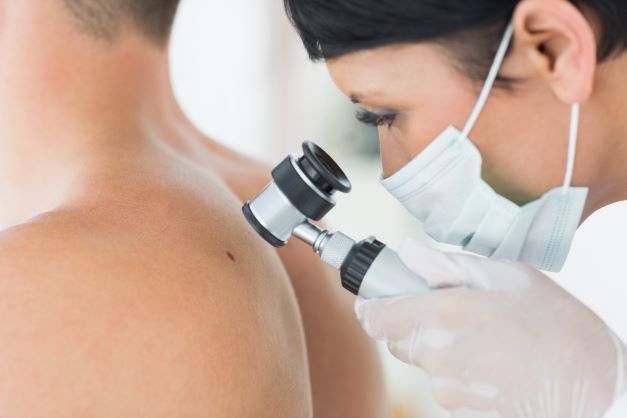Skin cancer is a common form of cancer, but many people aren’t aware of just how prevalent the condition is or how high their risk for developing skin cancer may be. According to Dr. Daniel Condie of U.S. Dermatology Partners in Plano, Sherman, and Grapevine, Texas, “Sharing statistics about skin cancer prevalence and individual risk is a great way to encourage people to keep up with their regular self-exams and annual screenings. I know how important early intervention is for effective treatment of skin cancer, and by sharing the statistics with my patients, I hope they feel empowered to take action to prevent skin cancer or receive an earlier diagnosis.” In this blog, Dr. Condie will review the top five skin cancer statistics you should know from the researchers at the Skin Cancer Foundation.
1 – Having 5 or More Sunburns Doubles Your Risk for Melanoma
According to Dr. Condie, “There are actually multiple types of skin cancer. The most common types are basal cell carcinoma and squamous cell carcinoma. Melanoma, while less common than basal cell or squamous cell carcinoma, is more aggressive and accounts for the highest mortality rate. The good news is melanoma is a highly preventable form of skin cancer. By taking steps to minimize sun exposure and protecting the skin during sun exposure, most people will have a low risk of developing melanoma. Plus, sun exposure is the main source of skin aging, so minimizing exposure will also keep your skin looking younger.”
Everyone should take the following steps to minimize sun damage from UVA and UVB rays:
- Use a broad-spectrum sunscreen with SPF 30 or higher each day on any areas of skin exposed to sunlight (even if it’s cloudy or cold outside)
- Minimize time outdoors during peak sun exposure hours between 10 am and 2 pm
- Reapply sunscreen at least every two hours or more frequently if you’re sweating or in the water
- Take breaks from sun exposure if you’re outdoors for long periods by seeking shade or going inside periodically (this is also a great opportunity to reapply sunscreen)
- Cover skin with long-sleeved shirts, pants, gloves, and hats if you’ll be outdoors for long periods, especially if you have a fair complexion or are otherwise at higher risk for skin cancer
2 – With Early Detection, the 5 Year Survival Rate for Melanoma is 99%
When it comes to melanoma survival rates, Dr. Condie says, “Early intervention is essential for effective melanoma treatment. One of the main reasons melanoma is associated with such a high mortality rate is that many melanoma cases are discovered in the advanced stages. With early intervention, melanoma is very responsive to treatment. The key to reducing the risk of death associated with melanoma is simple – we need to raise patient awareness and help them understand what the warning signs are. If patients bring melanoma to their dermatologist’s attention more quickly, the cancer is more likely to be responsive to treatment.”
Performing regular at-home screenings is the most important step that any patient can take to increase the chances that skin cancer will be diagnosed and treated in earlier stages. Patients should screen for melanoma and other skin cancers once a month if they are at high risk. Those with lower risk can screen every other month or every few months. During skin cancer self-exams, patients should carefully examine their bodies from the scalp all the way to the bottoms of the feet. Note the spots on the skin, and look for the following common indicators of skin cancer:
- A – Asymmetry – A spot looks different on one side
- B – Border – The outside edge of the spot is not smooth
- C – Color – The spot is different in color compared to other spots or has multiple colors within the same lesion
- D – Diameter – The spot is larger in diameter than a traditional pencil eraser
- E – Evolution – The spot is changing quickly
3 – More Than 2 People Die of Skin Cancer in the U.S. Every Hour
Dr. Condie says, “Skin cancer prevention and early intervention are key to reducing the number of annual deaths related to this condition. In addition to regular at-home screenings for skin cancer warning signs, patients can significantly reduce their risk of developing skin cancer by visiting their dermatologist once a year for a professional exam and skin cancer screening. This is especially important for those who are at higher risk of developing skin cancer.”
4 – 1 in 5 Americans Develop Skin Cancer by the Age of 70
The risk of developing skin cancer and other skin health issues increases with age. From cosmetic changes to serious health concerns, it becomes increasingly important to visit a dermatologist regularly as we grow older. Additionally, it may be beneficial for older adults to perform more frequent self-exams to ensure any changes in skin health are evaluated right away by a dermatologist.
5 – 9,500 People Are Diagnosed with Skin Cancer Daily in the U.S.
More people in the U.S. are diagnosed with skin cancer than all other forms of cancer combined. According to Dr. Condie, “Skin cancer is very common, and in most cases, it’s a highly treatable form of cancer. The sooner a dermatologist can diagnose skin cancer and begin treatment, the more likely patients are to make a full recovery. Regular self-screenings are essential, especially for patients who are at an increased risk of developing skin cancer.”
While anyone of any age can develop skin cancer, there are some common factors associated with an increased risk for skin cancer, including:
- Lighter skin – Fair-complected people, especially those who have experienced numerous or severe sunburns.
- Genetics – A family history of skin cancers, especially melanoma.
- Increased sun exposure – Living in a very sunny climate, especially at a high altitude, or spending time outdoors frequently.
- Tanning beds – Like long-term or repeated sun exposure, regular use of tanning beds can also damage skin, leading to skin cancer.
- Having numerous freckles and moles – Individuals who have non-cancerous freckles and moles, especially those who have numerous spots.
- Radiation and chemical exposure – People who work with chemicals or radiation regularly and those who receive certain chemical or radiation-based medical treatments.
Visit U.S. Dermatology Partners for an Annual Screening
If you’re concerned that a spot on your skin may be skin cancer or it’s time for your annual screening, don’t hesitate to reach out to the U.S. Dermatology Partners team in your area. By completing our simple online scheduling request, you can get started working with our knowledgeable dermatologists quickly at any time.
Find a location near me
or


